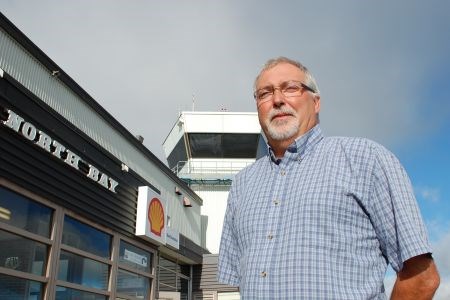The picture of what future business opportunities can grow out at North Bay’s Jack Garland Airport will become clearer when a consultant’s report is released this fall.
City officials didn’t hang their heads for very long after losing out to Montreal in landing Dornier Seaplane’s assembly plant this past summer. They are plunging ahead with a strategy to expand the Aerospace Park and create a new aviation and industrial park.
North Bay’s economic development manager Rick Evans hopes to attract a mix of aviation, aerospaceand manufacturing clients to a proposed 526-acre development which will be built in three stages as tenants and infrastructure dollars come in.
With a council-approved draft and subdivision plan in hand, Evans said the response so far from local and outside companies has been “extremely positive.”
“It wouldn’t surprise me if we had some local companies expand up there.”
Serviced industrial land in North Bay is in short supply. At the airport, there’s an opportunity to use its vast acreage of flat land to build out North Bay’s impressive aerospace sector, which employs almost 600 people.
What types of companies might come will be revealed in October when the results of a survey are reviewed by city and airport officials.
In early summer, a questionnaire was circulated to North Bay area businesses to gauge their interest in moving to a larger space at the airport, and also gather passenger numbers to possibly attract a new carrier. Jacobs Consultancy, a leading marketing and strategic planning firm, handled the survey and is writing the study which will form the foundation for an airport strategic plan.
The city’s development plan shows 202 acres of airside property and 324 acres of groundside property, ranging in size from 2.6 acres up to 31 acres, but those lot sizes will be flexible. The first phase of development would be along the airport’s south side in the vicinity of the Aerospace Park where Bombardier and Voyageur Airways currently reside.
There are a few acres of serviced land in the park and near Canadore College’s School of Aviation, campus along with a vacant 17,000-square-foot hangar that is ready for occupancy.
The city spent $7 million to erect a water tower and is counting on Northern Ontario Heritage Fund and FedNor to assist with sewer, water and power hookups to service potential tenants.
As development later moves on to the airport’s north end, the city intends to extend and beef up Four Mile Lake Road for truck traffic to connect with Highway 11.
Evans hopes the Jacobs report will validate some of their assumptions, but they remain open-minded to any opportunity. “We’re concentrating on industrial projects with some unique technology aspects to do applied research.”
During the city’s pursuit of Dornier Seaplane, Evans was introduced to aviation composites during a March trip to Wichita, Kan., a major aerospace manufacturing and research hub.
Composites types like fibreglass, Kevlar and carbon fibre are increasingly being used in aircraft construction, canoes and auto parts for their durability and reduced weight.
“Dornier would have been a real win for us, not only because of the aircraft, but we would have had physical leverage to grow the composites,” said Evans.
Last May, Dornier Seaplane Company announced they were bypassing North Bay to locate their 250-job assembly plant for its Seastar amphibious plane in a Montreal suburb. The Quebec government outbid Queen’s Park with the enticement of a $35-million loan, almost half of the entire $71.5-million project.
There are no hard feelings toward Dornier though, said Evans. The relationship they formed with Dornier CEO Joe Walker over the eight-month courting period remains strong to this day and they continue to talk about possible business leads.
“He’s a real champion for North Bay. He liked the location. There’s no doubt in my mind and Joe’s they could’ve been successful in this location.”
Fortunately, the attention North Bay received in the North American aviation sector because of Dornier was all positive and has led to other prospects. Airport manager Jack Santerre said if they took anything away from that year-long experience, it’s to be “shovel-ready” when companies call.
“North Bay from an infrastructure (perspective) is probably one of the crown jewels in Ontario for its development potential.”
Besides a 10,000-foot long runway, the airport has protected noise and flight test corridors used by companies like Bombardier and Field Aviation, who ferry aircraft up from Toronto for testing in North Bay’s less congested airspace.
Though reluctant to talk about specific Aerospace Park opportunities, Santerre said Jack Garland could use an aircraft paint shop, another maintenance and repair shop, and could serve as a maintenance base for an airline.
When asked if North Bay could use another passenger carrier like Porter Airlines, Santerre said simply, “We’re open for business.”
With the main runway repaved last year courtesy of the federal government’s G-8 fund, North Bay is poised to investigate the potential of air cargo operations.
The biggest obstacle is finding freight backhaul opportunities. Opportunities could improve with the completion of the Highway 11 four-laning south to Toronto by 2012.
Evans said their niche might be shipping outbound cargoes of mining equipment and other heavy machinery to projects around the world.
“If we get three or four flights a week, we can make a business of it.”




